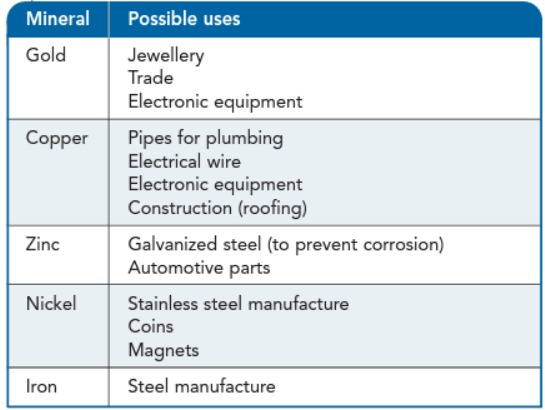Minerals
- Minerals are solid inorganic substances with clearly defied composition and properties.
Mineral Classification
Color
element that gives them their color is part of their chemical composition.
a. Idiochromatic: elements with specific and non-alternative color are known as “==idiochromatic== “.
b. Allochromatic: minerals with varying color are known as “==allochromatic== “.
Transparency
the quality that allows the passage of a specified form of radiation.
a. Transparent- minerals that ==allow light to pass== straight through them.
b. Translucent- minerals who ==light through==, but it is impossible to distinguish an object.
c. Opaque- minerals that ==do not let any light go through== them.

Hardness
- Hardness of a substance depends on the strength of the bonds; how close the atoms are to each other.
- It is measured by ==Mohs== scale which shows its hardness, measured by its resistance to scratching.
- Talc is no. 1 on this scale - very fragile.
- Diamond is no.10 on this scale - very hard.
Streak
- it is a powder trace that is left when it is rubbed against a rough surface. The color of the mineral sand might be different from its mineral, but its constant. This trace is called “==Streak== “.
Idiochromatic leaves a brightly colored powder.
Allochromatic leaves a white or a pale powder.
Mining
Geologists must first find the minerals and then extract them from the lithosphere in order to mine them and turn them into a variety of useful artifacts.
In Quebec, gold, copper, zinc, nickel, and iron are the minerals most extract.
Mining entails time-consuming and expensive processes. An open pit mine is constructed if the deposit is close to the surface. With the aid of drilling equipment, excavators, and massive dump trucks, the uppermost layers of the ground are gradually removed, and the ore is retrieved.

What makes a mineral…a mineral?
A mineral must fit in these criteria, it must be:
- [ ] Solid
- [ ] Naturally occurring
- [ ] Inorganic
- [ ] Specific chemical composition
- [ ] Definite structure
Other key points
- Rocks are generally made of two or more minerals, mixed through geological process.
- Malleable - able to be pressed permanently out of shape without breaking.
- Mid-oceanic ridges occur along divergent plate boundaries, where new ocean floor is created as the Earth’s tectonic plates spread apart. (Separate)
- Allochromatic- light absorbing defects in the atomic structure or impurities in the crystal can produce minerals with a variety of colors. This gives red, green, yellow, or blue variations of Quartz, diamond, etc.
- Ore- Naturally occurring solid material from which a metal or valuable mineral can be profitable. (extracted)
- The color of a mineral depends on its chemical structure.
- The hardness of a mineral depends in its atomic structure.